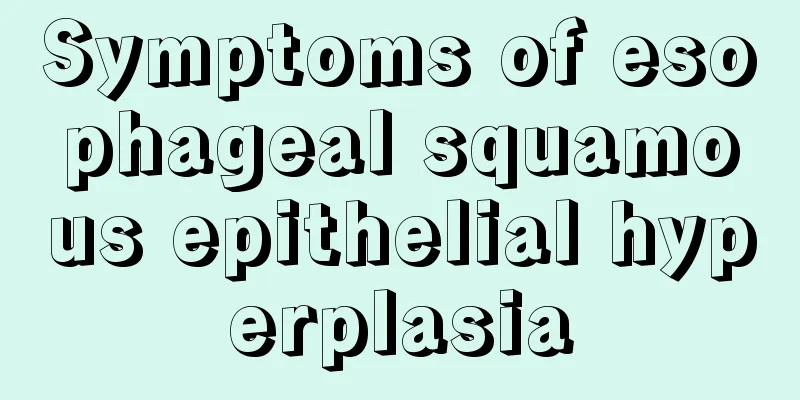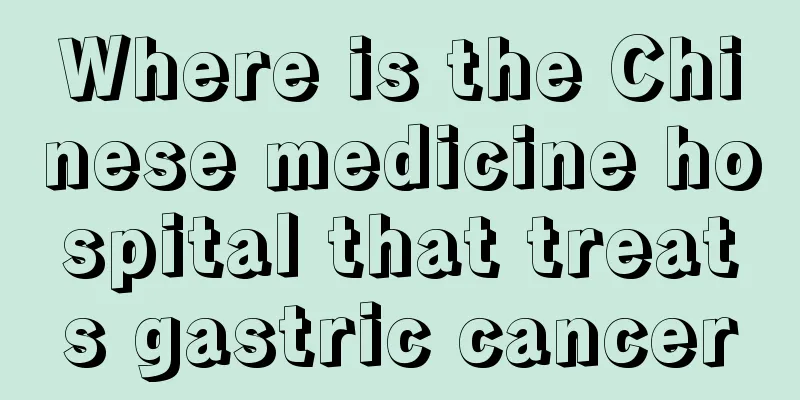Symptoms of esophageal squamous epithelial hyperplasia

|
In life, some patients are troubled by esophageal squamous epithelial hyperplasia, so how much do you know about it? Let me introduce to you the symptoms of esophageal squamous epithelial hyperplasia. (1) Foreign body sensation in the esophagus: The location of the foreign body sensation is often consistent with esophageal lesions. As the disease progresses, symptoms such as choking when swallowing food and even pain may appear. The cause of this symptom may be that the mucosal congestion and swelling at the site of esophageal lesions reduces the stimulation threshold of the esophageal submucosal nerve plexus. (2) Slow passage of food and a feeling of stagnation: After swallowing food, the food moves down slowly and there is a feeling of stagnation. The disease is more common in the upper and middle esophagus. It is often mild at first, gradually worsens, and is accompanied by other symptoms. The mechanism may be mainly functional changes, or it may be due to the wider "cancerous field" of esophageal cancer and the varying degrees of chronic inflammation of the esophageal mucosa. (3) Pain behind the sternum, stuffy discomfort, or pain when swallowing: The pain may be burning, stabbing, or pulling and friction-like. Symptoms are mild in the initial stage and occur only intermittently. Each episode may last for a short time and may be relieved by medication. Later, the symptoms worsen, recur, and last longer. (4) Dryness and tightness of the throat: This is an abnormal feeling that may be caused by esophageal lesions causing the pharyngeal esophageal sphincter to contract in the opposite direction. (5) Pain under the xiphoid process or in the upper abdomen: It manifests as persistent dull pain or burning pain, which often occurs when swallowing food and weakens or disappears after eating, and is inconsistent with the location of the lesion. It may be caused by the uncoordinated esophageal motility caused by the lesion, resulting in strong spasmodic contraction of the cardiac sphincter. (6) Hoarseness: When cancerous tissue invades or compresses the recurrent laryngeal nerve, vocal cord paralysis occurs, and the patient experiences hoarseness or even aphonia. This is more common in upper esophageal cancer involving the left recurrent laryngeal nerve. Sometimes enlarged metastatic lymph nodes compress the recurrent laryngeal nerve, causing the patient to have hoarseness symptoms. When eating, the patient often has choking and coughing due to aspiration, which sometimes causes aspiration pneumonia. Laryngoscopy shows that the vocal cord on the affected side cannot be abducted but is in the midline position, indicating vocal cord paralysis. The affected vocal cord is usually the left vocal cord, occasionally the right vocal cord. (7) Hiccups: These are often manifestations of esophageal cancer itself or metastatic mediastinal lymph nodes invading (compressing) the phrenic nerve, leading to diaphragmatic paralysis and motor dysfunction. (8) Vomiting: It often occurs when dysphagia worsens. Initially, vomiting occurs whenever choking occurs. Later, vomiting occurs whenever eating. In severe cases, vomiting occurs even without eating. Vomitus is mostly things that cannot be swallowed, mainly mucus and food retained above the narrow part of the esophagus. (9) Respiratory system symptoms: Aspiration and direct invasion of the trachea and bronchi by the tumor may cause the patient to experience cough, dyspnea, and pleuritic chest pain. When swallowing liquid, patients with high esophageal cancer may experience reflux of liquid into the trachea due to esophageal lesions, causing coughing and difficulty breathing. In addition, due to the invasion of cancerous tissue, if the tumor penetrates the trachea and bronchi, mediastinum or large blood vessels in the mediastinum, the patient will show tracheoesophageal fistula, acute mediastinitis or even fatal massive bleeding. At the level of the tracheal carina, the front edge of the left main bronchus is adjacent to the middle esophagus. If the middle esophageal cancer penetrates the left main bronchus, leading to esophageal-tracheal, esophageal-bronchial fistula and aspiration pneumonia, characteristic choking and coughing after swallowing may occur. In severe cases, pneumonia and lung abscess may occur, and some patients may experience hemoptysis. (10) Weight loss: Weight loss is the second most common symptom of esophageal cancer patients. According to an analysis of a large number of esophageal cancer cases (more than 1,000 cases), about 40% of patients experience weight loss, which is mainly related to dysphagia, vomiting and pain, and is also related to the consumption caused by the tumor itself. If the patient has obvious weight loss and systemic malnutrition, it usually indicates that the tumor has reached an advanced stage, which is also one of the clinical manifestations of cachexia. The above is the answer to esophageal squamous epithelial hyperplasia. Maybe words cannot give you the most appropriate answer. If you have any problems, you must seek timely treatment. I hope everyone pays attention to their physical health. |
<<: Methods for treating snoring and breath holding
>>: Diet therapy for patients with right leg fracture
Recommend
Can I sleep with beeswax on?
Beeswax is actually a type of amber. Because its ...
Side effects of thread embedding
Thread embedding for weight loss is a very good w...
What are the dangers of cross syndrome
Upper body examination syndrome is a very common ...
Which kind of pollen can beautify and remove freckles
Beauty freckle removal is an activity that modern...
Are radiotherapy suitable for elderly patients with mid-stage esophageal squamous cell carcinoma?
Malignant tumors consume the body's nutrition...
Is thread embedding useful for chronic gastritis
Gastric disease is a very common disease in life,...
What to do if I have allergic reactions and bumps all over my body
In daily life, many people suffer from allergies ...
Which gas in the gas causes gas poisoning?
In recent years, the country has been vigorously ...
Can nasopharyngeal carcinoma be inherited in the family? How to diagnose nasopharyngeal carcinoma
Does nasopharyngeal carcinoma run in the family? ...
Physiological functions of the small intestine
The physiological structure of the small intestin...
What are the first aid methods for myocardial infarction
Patients with myocardial infarction are very comm...
What to do if facial cleanser gets into eyes
Facial cleansers are chemicals after all. Althoug...
What to do if lymphoma relapses for the third time
What should I do if lymphoma relapses for the thi...
How to quickly remove smoke smell
You may often encounter this situation: a group o...
What are the misunderstandings about the treatment of uterine fibroids? Treatment methods for uterine fibroids
Uterine fibroids are the most common benign tumor...









